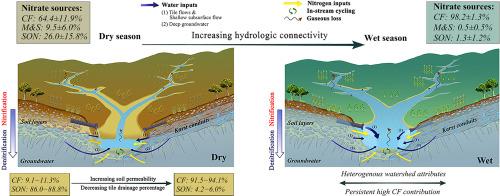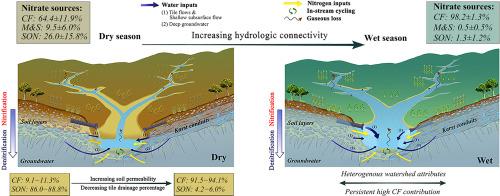Combining stable isotopes and spatial stream network modelling to disentangle the roles of hydrological and biogeochemical processes on riverine nitrogen dynamics
IF 11.4
1区 环境科学与生态学
Q1 ENGINEERING, ENVIRONMENTAL
引用次数: 0
Abstract
Intensive agricultural activities have significantly altered watershed hydrological and biogeochemical processes, resulting in water quality issues and loss of ecosystem functions and biodiversity. A major challenge in effectively mitigating nitrogen (N) loss from agricultural watersheds stems from the heterogeneity of N transformation and transport processes that complicates accurate quantification and modeling of N sources and sinks at the watershed scale. This study utilized stable isotopes of water and nitrate (NO3−) in conjunction with spatial stream network modeling (SSNMs) to explore watershed hydrology, N transformation, and sources within a mesoscale river network in the U.S. Corn Belt (Cannon River Watershed, Minnesota) under contrasting hydrological conditions. The results show that the wet season had elevated riverine NO3− concentration (medium: 8.4 mg N L−1), driven by high watershed wetness conditions that mobilizes NO3− from the near-surface source zone. Furthermore, the strong hydrologic connectivity also reduced the denitrification potential by shortening water travel times. In comparison, the dry season showed lower NO3− concentrations (0.9 mg N L−1) and stronger denitrification NO3− isotope signals. During this period, the decrease in hydrologic connectivity shifted the predominant water source to deep groundwater, with longer water travel time promoting denitrification. After accounting for isotopic fractionations during nitrification and denitrification, we identified fertilizer N as the main NO3− source during the wet season (98.2±1.3%), whereas the dry season showed contributions from diverse sources (64.4±11.9% fertilizer, 26.0±15.8% soil N, and 9.5±6.0% manure and sewage). During the dry season, karst regions with high hydrologic connectivity display increased shallow groundwater inputs, carrying elevated NO3− levels from leaching of applied chemical fertilizers. These findings highlight the importance of integrating drainage water management and N accumulation in groundwater into nutrient management strategies to develop adaptive measures for controlling N pollution in agricultural watersheds.


结合稳定同位素和空间溪流网络模型,厘清水文过程和生物地球化学过程对河流氮动态的作用
集约化农业活动极大地改变了流域水文和生物地球化学过程,导致水质问题以及生态系统功能和生物多样性的丧失。有效减缓农业流域氮(N)流失的一个主要挑战是氮转化和迁移过程的异质性,这使得流域尺度上氮源和氮汇的精确量化和建模变得复杂。本研究利用水和硝酸盐(NO3-)的稳定同位素,结合空间溪流网络建模(SSNMs),探索了美国玉米带(明尼苏达州坎农河流域)中尺度河网在不同水文条件下的流域水文、氮转化和来源。结果表明,湿季河水中 NO3-浓度升高(中等:8.4 毫克 N L-1),这是由于高流域湿度条件动员了近地表源区的 NO3-。此外,强大的水文连通性也缩短了水的流动时间,从而降低了反硝化的可能性。相比之下,旱季的 NO3- 浓度较低(0.9 毫克 N L-1),反硝化 NO3- 同位素信号较强。在此期间,水文连通性的降低使主要水源转向深层地下水,水流时间的延长促进了反硝化作用。考虑到硝化和反硝化过程中的同位素分馏,我们确定化肥氮是雨季的主要 NO3-来源(98.2±1.3%),而旱季则有多种来源(64.4±11.9% 化肥氮、26.0±15.8% 土壤氮、9.5±6.0% 粪便和污水氮)。在旱季,水文连通性高的岩溶地区浅层地下水输入量增加,施用化肥沥滤产生的 NO3- 含量升高。这些发现凸显了将排水管理和地下水中的氮积累纳入养分管理策略的重要性,从而制定出控制农业流域氮污染的适应性措施。
本文章由计算机程序翻译,如有差异,请以英文原文为准。
求助全文
约1分钟内获得全文
求助全文
来源期刊

Water Research
环境科学-工程:环境
CiteScore
20.80
自引率
9.40%
发文量
1307
审稿时长
38 days
期刊介绍:
Water Research, along with its open access companion journal Water Research X, serves as a platform for publishing original research papers covering various aspects of the science and technology related to the anthropogenic water cycle, water quality, and its management worldwide. The audience targeted by the journal comprises biologists, chemical engineers, chemists, civil engineers, environmental engineers, limnologists, and microbiologists. The scope of the journal include:
•Treatment processes for water and wastewaters (municipal, agricultural, industrial, and on-site treatment), including resource recovery and residuals management;
•Urban hydrology including sewer systems, stormwater management, and green infrastructure;
•Drinking water treatment and distribution;
•Potable and non-potable water reuse;
•Sanitation, public health, and risk assessment;
•Anaerobic digestion, solid and hazardous waste management, including source characterization and the effects and control of leachates and gaseous emissions;
•Contaminants (chemical, microbial, anthropogenic particles such as nanoparticles or microplastics) and related water quality sensing, monitoring, fate, and assessment;
•Anthropogenic impacts on inland, tidal, coastal and urban waters, focusing on surface and ground waters, and point and non-point sources of pollution;
•Environmental restoration, linked to surface water, groundwater and groundwater remediation;
•Analysis of the interfaces between sediments and water, and between water and atmosphere, focusing specifically on anthropogenic impacts;
•Mathematical modelling, systems analysis, machine learning, and beneficial use of big data related to the anthropogenic water cycle;
•Socio-economic, policy, and regulations studies.
 求助内容:
求助内容: 应助结果提醒方式:
应助结果提醒方式:


